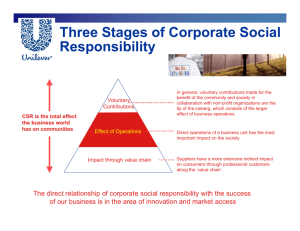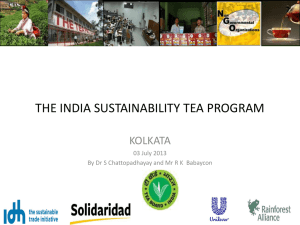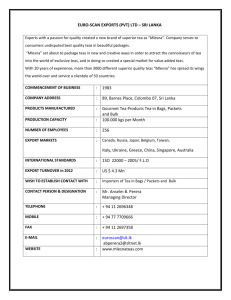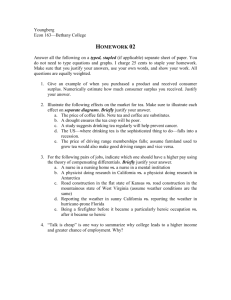Target Groups
advertisement
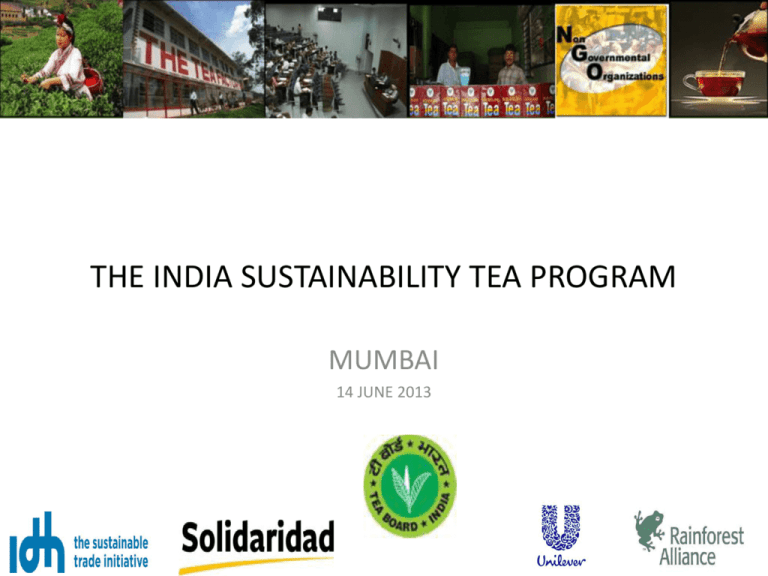
THE INDIA SUSTAINABILITY TEA PROGRAM MUMBAI 14 JUNE 2013 Why sustainable tea production? • Improved food safety standards – – • Eliminate foreign bodies Controlled pesticide usage Improved quality – – Better in process controls Compliance to FSSAI norms • Inclusion of small holders farmers in mainstream business • Adaptation & mitigation of adverse climate change effects. – • Protection of National ecosystems (soil, water. Biodiversity) Companies focussing on responsible and ethical sourcing – – Large Global companies - Tetley, Twinings, Taylors, Sara Lee & Unilever – committed to sustainable sourcing for their teas Global retailers are demanding this from the tea companies • Consumers are increasingly demanding sustainable and responsible products • Long-term security of business for both producers and buyers – – Better agricultural practices to improve productivity. Improved quality of life for workers and small tea farmers. Consumers are already differentiating between companies based on the sustainability of their products Source - Edelman goodpurpose® 2012 Consumers in Rapid Growth Economies (RGEs) appear to care more than their Western colleagues Source - Edelman goodpurpose® 2012 China, India, Indonesia, UAE, Brazil USA, Western Europe Why do we need locally owned standards? 1. The top down-fit all approach of global standards is resisted by the stakeholders even when there is a export market. Cultural and technical issues come on the way. 1. Governments and stakeholders resist the carrot and stick policy and prefer to engage with the ones more rooted to local realities. (E.G. ISPO from Indonesia, China Social Compliance 9000, IS 16001 from India). 1. India, China and Indonesia are the biggest producer and consumer of most agrocommodities. Yet, most international standards do not operate in these markets. 1. International standards are costly to implement in a low margin business model of Asia. 1. Global businesses are increasingly seeking to provide sustainable products to all customers in all markets (i.e. Unilever, Coca Cola, Pepsi, Mars, Nestle) Co-existance of national and internation standards is not new Garments Palm oil What are the key Sustainability challenges for Indian tea production? • Stagnating yield levels • Smallholders under-performing larger estates • Wages and poor working conditions • Low literacy levels • Lack of farmer groupings • Improper storage & usage of chemicals and fertilizers • Low awareness of Health & Safety issues • Incorrect disposal of waste • Water pollution and soil erosion • Habitat destruction • Poor record keeping Resulting in: 1. 2. 3. 4. 5. Consumer safety issues Low yield Limited knowledge of hygiene Arbitrary use of pesticides Global reputational risk What do we intend to do? • Develop and implement an India specific, sustainability ‘code’ for tea. – OF THE INDUSTRY, BY THE INDUSTRY, FOR THE INDUSTRY • Drive Independent verification vs. “branded” certification • Focus on Tea factories to implement the verification process program • Set up training tools and programmes to help farmers & factories to get verified and become more sustainable. In do doing.. Cover 50%+ of Indian Tea by 2016 ( approx 500 million kg) Project Implementation: some key actions… Budget: Total cost est. INR 180m over 5 years • Initial budget secured by HUL and IDH Target Groups: • 600+ factories • 500000 farm workers • 40000 smallholders (via smallholder groups) •On the ground Operations: Farmer Support Centres (FSC) established to help target groups get verified: • • • • • Audit targeted Factories & Farmer Groups (F & FG) to evaluate gaps in current practices vs. the code Guide & help Implement formation of small holder groups Training F&FG on Sustainability Code & Good Agricultural Practices Implement cost effective improvement plans (closing the gap) Move the Farmers/Farmer Groups to be capable of doing self audits vs code in readiness for verification & for continuous improvements Code elements Chapter 1: Management system and continuous improvement Chapter 2: Product traceability Chapter 3: Soil conservation and management Resulting Chapter 4: Water Management in: 1. Improved consumer safety Chapter 5: Fertilizers 2. Higher yields 3. Improved hygiene in factories Chapter 6: Crop protection Products –( CPP) 4. Controlled and Safe handling /use of pesticides 5. Healthier and happier work force Chapter 7: Food safety 6. Improved environment Improved image of Indian Tea globally Chapter 8: Safety, health and7. welfare of the workforce Chapter 9: Working conditions and labour rights Chapter 10: Biodiversity and environmental management Chapter 11: Waste and pollution management Program Organisation Steering Committee Program Coordination Major Funders IDH Program Management Committee Funders and key Partners Program Advisory Committee Tea Board & respresentatives of key Indian stakeholders Implementers Solidaridad Progress to Date • Program Management Committee (PMC) and Steering Group (SG) established • Implementing partner, Solidaridad, appointed for delivering the programme • 5 year implementation plan in place • Stakeholder briefings and support (TBOI, FAITTA, NSTGA, ITA, UPASI) • Tea Board agrees to champion the program • Program Advisory Committee (PAC) formed with Tea Board as its Chair • Draft sustainability code prepared and shared with PAC. • 3 Farmer Support Centres (FSCs) and 6 pilot projects soon to be launched • Program launch in 11 July 2013 in Kolkata. YOU ARE INVITED. Why is this important for the Indian tea industry? • “Certified” Safe and hygienic teas – Safer, healthier and more environmentally friendly teas • Get industry ready for future consumer & customer demands • Safeguard the competitiveness of the Indian tea industry. • Improved relationships and loyalty in the supply chain & other stakeholders • Long term security of supply for the Indian tea market • Healthier farms, workers and the environment • International recognition of sustainable tea practices in India = GOOD QUALITY TEA !


